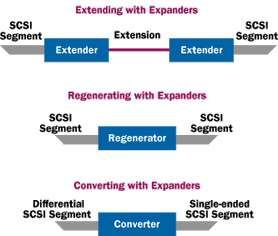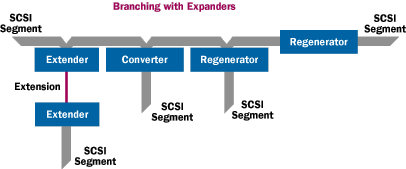| |||||||||||||||||||||||||||||||
|
THE CASE FOR SCSI EXPANDERS The Small Computer Systems Interface (SCSI) has developed into the most versatile interface for communicating between computers and mass storage devices. This is due in a large part to the flexibility built into the standard. The ANSI X3T10 Standards Committee has continued to adapt the SCSI standard to the increased demand for faster and more complex data communications. It has done this while allowing older and slower SCSI implementations to continue to be supported. Logical definitions of how SCSI devices communicate on the bus are exceptionally clean. The physical layer of the bus however, has continued to pose problems. SCSI extenders, regenerators, converters, and other SCSI bus enhancement devices can be used to alleviate many of those problems. SCSI AND "OTHER " DEVICES SCSI allows for peripherals other than mass storage devices to be used. Other devices such as high speed scanners, printers, data acquisition systems, video recorders, and any device that incorporates the SCSI interface hardware can be connected to a system, and have the standardized, high speed communications that SCSI provides. Unfortunately, the cable length limitations of parallel SCSI represent a major problem in configuring systems with these "other" devices. The 1.5 to 6 meter maximum length of single ended SCSI and even the maximum of 25 meters for differential (HVD) SCSI, in many cases is too short for the above devices to be physically located where they need to be used. In many systems RAID packages, backup devices and other mass storage devices frequently encounter the same cable length problems as the "other" SCSI devices. SCSI EXTENDERS
SCSI REGENERATORS SCSI bus regenerators also provide a solution to cable length problems. Regenerators are a class of SCSI bus repeaters that receive and transmit all of the signal lines on the bus completely isolating each segment of the bus it separates. Each segment of the bus may independently have the regenerator at the end of the segment with termination at the regenerator, or somewhere in the middle of the segment, with termination away from the regenerator. SCSI repeaters have been around for many years in various forms. Implementations of repeaters have varied all the way from simply reshaping the REQ and ACK lines to support longer distances, to fully regenerating and isolating all bus signals and terminations. The SCSI bus has increased in performance to the point that repeaters that do not fully regenerate the bus may not operate properly at Fast or Ultra SCSI rates. Thus the differences in functionality between regenerators and other repeaters warrants the name distinction. SCSI WIDE, NARROW, SINGLE ENDED, DIFFERENTIAL, LVD . . . The SCSI standard has allowed for both single ended and differential parallel signal communications methods, and is in the process of adding a low voltage differential (LVD) method, along with a number of serial SCSI methods. Each transmission type has its advantages. The majority of SCSI based devices in use today are narrow (8 bit) single ended. This is due to the relatively low cost of the drivers and receivers used in implementing a single ended interface. Wide (16 bit) devices are increasing in market share due to the increase in throughput that they provide. Once a system requires more than one or two internal mass storage devices, differential SCSI becomes more desirable, but with drive manufacturers producing as low as 4% of their SCSI drives as differential (HVD), and the additional cost of the differential (HVD) transceivers, the popularity of differential remains mostly in the larger systems. Both single ended and differential (HVD) SCSI are also reaching their limits in the physical transmission rates they can support. LVD and Universal LVD will potentially provide the longer lengths of differential at the lower costs of single ended, and will allow for faster parallel SCSI communications in the future. Double wide (32 bit) SCSI is defined in the standard, but won't become readily available until the current physical connector concepts become more acceptable to device manufacturers. SCSI CONVERTERS All of the above parallel physical implementations of the bus have increased the demand for converters to allow various SCSI bus types to communicate with each other. Devices that convert between single ended and differential SCSI expand the capabilities of the SCSI bus. Converters provide differential SCSI systems access to lower cost, easier to find, single ended SCSI devices. They allow value added resellers to inventory single ended drive packages, and provide a converter to support customers with differential SCSI requirements. Used back to back as extenders, they allow single ended systems to attain longer cable lengths for their external devices. SCSI converters have been in existence since the early 1980s. They are being used to support the upgrading of current systems and are taking an increasing role in new system implementations.
SCSI EXPANDERS TIE IT ALL TOGETHER The X3T10 Standards Committee for SCSI has recognized that the SCSI standard does not take into account the use of devices which enhance the capabilities of the SCSI bus. There is now an Enhanced Parallel Interface (EPI) group within X3T10 which is addressing these issues. The EPI group currently calls the class of devices that enhance a physical parallel SCSI bus, Expanders. This group is working on a technical report which will recommend expander requirements and methods to properly implement systems using expanders. Extenders, Regenerators, Converters and other SCSI enhancement devices will be included as Expanders in the report. The document is in its early stages of development, but already has defined terms that help to clarify what expanders do. Specifically it describes the concept of SCSI bus segments. Segments of a SCSI bus electrically have a single path of devices that have a termination at each end. A SCSI domain contains one or more SCSI bus segments. Expanders provide the glue between segments within a SCSI domain. Expanders allow all devices within the domain to communicate as if there is no segmentation of the domain. Expanders differ from bridges that connect two domains together. Whereas an expander stays within the specifications of a domain, bridges provide a window of communications between two domains, and may look like a device to one or both of the domains. The technical report from the standards committee is not part of the current standard, but when released it will provide a guideline for the concepts that go into expander designs. In summary, as parallel SCSI continues to improve in performance, expanders will have an increased role in implementing parallel SCSI based systems. PDF of - The Case for SCSI Expanders. For more information contact: STA (SCSI Trade Association, Web Site--www.scsita.org) (Facilitation--Michael LoBue, LoBue Company, 404 Balboa St, San Francisco, CA 94118. T10 ( T10 Technical Committee, Web Site--http://www.t10.org) (Facilitation--John Lohmeyer, Chairperson 415-750-8351 or john.lohmeyer@t10.org) Marc D. Brooks is an active member of the STA and founder and CEO of Paralan Corporation, a manufacturer of SCSI bus enhancement products (Expanders) | |||||||||||||||||||||||||||||||
|
Paralan Corporation 4655 Ruffner Street, San Diego, CA 92111 Sales: (800) 479-7719 | Tel.: (858) 560-7266 | Fax: (858) 560-8929 | E-mail: info@paralan.com |
|||||||||||||||||||||||||||||||

Custom Search
|



 SCSI bus extenders solve the problem of placing these devices where they are required. Fiber optic, coaxial, and parallel SCSI extenders separate the bus into two segments. Each segment has its own set of physical terminations. The extenders do not take an ID on the bus and logically are transparent to the rest of the system. Extenders function in a manner that allows devices connected together through an extension to be accessible as if they were still connected together within a single segment. A point to point extension consists of two extenders that convert the SCSI signals from one segment to a different physical medium (fiber, coax, differential, etc...), then on the other side of the extension convert them back to SCSI signals. SCSI bus extenders have been commercially available since 1989 by a few manufacturers. A major issue when designing extenders is handling the arbitration and disconnect/reconnect timing associated with multi-threaded SCSI applications. In order for an extension to work properly in all applications, there are some serious timing considerations that SCSI extender manufacturers are addressing.
SCSI bus extenders solve the problem of placing these devices where they are required. Fiber optic, coaxial, and parallel SCSI extenders separate the bus into two segments. Each segment has its own set of physical terminations. The extenders do not take an ID on the bus and logically are transparent to the rest of the system. Extenders function in a manner that allows devices connected together through an extension to be accessible as if they were still connected together within a single segment. A point to point extension consists of two extenders that convert the SCSI signals from one segment to a different physical medium (fiber, coax, differential, etc...), then on the other side of the extension convert them back to SCSI signals. SCSI bus extenders have been commercially available since 1989 by a few manufacturers. A major issue when designing extenders is handling the arbitration and disconnect/reconnect timing associated with multi-threaded SCSI applications. In order for an extension to work properly in all applications, there are some serious timing considerations that SCSI extender manufacturers are addressing.